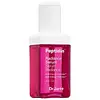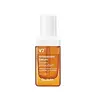What's inside
What's inside
 Key Ingredients
Key Ingredients

 Benefits
Benefits

 Concerns
Concerns

 Ingredients Side-by-side
Ingredients Side-by-side

Water
Skin ConditioningPentylene Glycol
Skin ConditioningGlycerin
HumectantMethyl Gluceth-20
HumectantAlcohol
AntimicrobialGlyceryl Polymethacrylate
Niacinamide
SmoothingPolyglycerin-3
HumectantMethylpropanediol
SolventPrunus Persica Flower Extract
MoisturisingPrunus Persica Leaf Extract
EmollientAlgae Extract
EmollientEclipta Prostrata Leaf Extract
Skin ConditioningOctyldodeceth-16
EmulsifyingPolyglyceryl-10 Laurate
Skin ConditioningBeta-Glucan
Skin ConditioningCamellia Japonica Flower Extract
EmollientAvena Sativa Kernel Extract
AbrasiveCynara Scolymus Leaf Extract
Skin ConditioningPteris Multifida Extract
AntioxidantRhododendron Ferrugineum Extract
MaskingLeucojum Aestivum Bulb Extract
Skin ProtectingEthylhexylglycerin
Skin ConditioningAdenosine
Skin ConditioningFructooligosaccharides
HumectantHydrogenated Lecithin
EmulsifyingCitrus Aurantium Bergamia Fruit Oil
MaskingPolyquaternium-51
Skin ConditioningSodium Hyaluronate
HumectantXanthan Gum
EmulsifyingAcrylates/C10-30 Alkyl Acrylate Crosspolymer
Emulsion StabilisingTromethamine
BufferingButylene Glycol
HumectantPropanediol
Solvent1,2-Hexanediol
Skin ConditioningHydrolyzed Hyaluronic Acid
HumectantLavandula Angustifolia Oil
MaskingCholesterol
EmollientCyanocobalamin
Skin ConditioningCaprylyl Glycol
EmollientGlycine
BufferingAcetyl Glutamine
Skin ConditioningDipalmitoyl Hydroxyproline
Skin ConditioningSodium Cocoyl Alaninate
Serine
MaskingGlutamic Acid
HumectantAspartic Acid
MaskingLeucine
Skin ConditioningAlanine
MaskingLysine
Skin ConditioningArginine
MaskingTyrosine
MaskingPhenylalanine
MaskingProline
Skin ConditioningThreonine
Valine
MaskingIsoleucine
Skin ConditioningHistidine
HumectantCysteine
AntioxidantMethionine
Skin ConditioningAcetyl Hexapeptide-8
HumectantCopper Tripeptide-1
Skin ConditioningHexapeptide-9
Skin ConditioningNonapeptide-1
Skin ConditioningPalmitoyl Pentapeptide-4
Skin ConditioningPalmitoyl Tetrapeptide-7
Skin ConditioningPalmitoyl Tripeptide-1
Skin ConditioningTripeptide-1
Skin ConditioningWater, Pentylene Glycol, Glycerin, Methyl Gluceth-20, Alcohol, Glyceryl Polymethacrylate, Niacinamide, Polyglycerin-3, Methylpropanediol, Prunus Persica Flower Extract, Prunus Persica Leaf Extract, Algae Extract, Eclipta Prostrata Leaf Extract, Octyldodeceth-16, Polyglyceryl-10 Laurate, Beta-Glucan, Camellia Japonica Flower Extract, Avena Sativa Kernel Extract, Cynara Scolymus Leaf Extract, Pteris Multifida Extract, Rhododendron Ferrugineum Extract, Leucojum Aestivum Bulb Extract, Ethylhexylglycerin, Adenosine, Fructooligosaccharides, Hydrogenated Lecithin, Citrus Aurantium Bergamia Fruit Oil, Polyquaternium-51, Sodium Hyaluronate, Xanthan Gum, Acrylates/C10-30 Alkyl Acrylate Crosspolymer, Tromethamine, Butylene Glycol, Propanediol, 1,2-Hexanediol, Hydrolyzed Hyaluronic Acid, Lavandula Angustifolia Oil, Cholesterol, Cyanocobalamin, Caprylyl Glycol, Glycine, Acetyl Glutamine, Dipalmitoyl Hydroxyproline, Sodium Cocoyl Alaninate, Serine, Glutamic Acid, Aspartic Acid, Leucine, Alanine, Lysine, Arginine, Tyrosine, Phenylalanine, Proline, Threonine, Valine, Isoleucine, Histidine, Cysteine, Methionine, Acetyl Hexapeptide-8, Copper Tripeptide-1, Hexapeptide-9, Nonapeptide-1, Palmitoyl Pentapeptide-4, Palmitoyl Tetrapeptide-7, Palmitoyl Tripeptide-1, Tripeptide-1
Water
Skin ConditioningOlea Europaea Fruit Oil
MaskingCoco-Caprylate/Caprate
EmollientCamellia Japonica Seed Oil
EmollientSimmondsia Chinensis Seed Oil
EmollientAlcohol
AntimicrobialGlycerin
HumectantNiacinamide
Smoothing1,2-Hexanediol
Skin ConditioningPentylene Glycol
Skin ConditioningSodium Chloride
MaskingHydrogenated Lecithin
EmulsifyingCoccinia Indica Fruit Extract
Skin ConditioningEclipta Prostrata Extract
Skin ConditioningPolyglyceryl-10 Stearate
Skin ConditioningEthylhexylglycerin
Skin ConditioningXanthan Gum
EmulsifyingCitrus Reticulata Peel Extract
Skin ConditioningPanthenol
Skin ConditioningPogostemon Cablin Leaf Extract
PerfumingSalvia Sclarea Oil
MaskingAdenosine
Skin ConditioningSodium Hyaluronate
HumectantTocopheryl Acetate
AntioxidantButylene Glycol
HumectantMelia Azadirachta Flower Extract
Skin ConditioningMelia Azadirachta Leaf Extract
Skin ConditioningCurcuma Longa Root Extract
MaskingOcimum Sanctum Leaf Extract
Skin ConditioningFicus Carica Fruit Extract
HumectantGinkgo Biloba Nut Extract
Skin ConditioningMorus Alba Fruit Extract
AntioxidantPunica Granatum Fruit Extract
AntioxidantCorallina Officinalis Extract
Skin ConditioningLinoleic Acid
CleansingBiotin
AntiseborrhoeicMenadione
MaskingAscorbic Acid
AntioxidantWater, Olea Europaea Fruit Oil, Coco-Caprylate/Caprate, Camellia Japonica Seed Oil, Simmondsia Chinensis Seed Oil, Alcohol, Glycerin, Niacinamide, 1,2-Hexanediol, Pentylene Glycol, Sodium Chloride, Hydrogenated Lecithin, Coccinia Indica Fruit Extract, Eclipta Prostrata Extract, Polyglyceryl-10 Stearate, Ethylhexylglycerin, Xanthan Gum, Citrus Reticulata Peel Extract, Panthenol, Pogostemon Cablin Leaf Extract, Salvia Sclarea Oil, Adenosine, Sodium Hyaluronate, Tocopheryl Acetate, Butylene Glycol, Melia Azadirachta Flower Extract, Melia Azadirachta Leaf Extract, Curcuma Longa Root Extract, Ocimum Sanctum Leaf Extract, Ficus Carica Fruit Extract, Ginkgo Biloba Nut Extract, Morus Alba Fruit Extract, Punica Granatum Fruit Extract, Corallina Officinalis Extract, Linoleic Acid, Biotin, Menadione, Ascorbic Acid
Ingredients Explained
These ingredients are found in both products.
Ingredients higher up in an ingredient list are typically present in a larger amount.
1,2-Hexanediol is a synthetic liquid and another multi-functional powerhouse.
It is a:
- Humectant, drawing moisture into the skin
- Emollient, helping to soften skin
- Solvent, dispersing and stabilizing formulas
- Preservative booster, enhancing the antimicrobial activity of other preservatives
Adenosine is in every living organism. It is one of four components in nucleic acids that helps store our DNA.
Adenosine has many benefits when used. These benefits include hydrating the skin, smoothing skin, and reducing wrinkles. Once applied, adenosine increases collagen production. It also helps with improving firmness and tissue repair.
Studies have found adenosine may also help with wound healing.
In skincare products, Adenosine is usually derived from yeast.
Learn more about AdenosineAlcohol comes in many different forms. Different types of alcohol will have different effects on skin. This ingredient is usually an astringent alcohol.
These alcohols are drying on the skin. They may strip away your skin's natural oils and even damage your skin barrier. Astringent alcohols may also irritate skin.
Other types of astringent alcohols include:
According to the National Rosacea Society based in the US, you should be mindful of products with these alcohols in the top half of ingredients.
Any type of sanitizing product will have high amounts of alcohol to help kill bacteria and viruses.
Fatty alcohols come from plant oils such as coconut oil. These can help hydrate the skin and are non-irritating. Some fatty alcohols include cetyl and stearyl alcohol.
Learn more about AlcoholButylene Glycol (or BG) is used within cosmetic products for a few different reasons:
Overall, Butylene Glycol is a safe and well-rounded ingredient that works well with other ingredients.
Though this ingredient works well with most skin types, some people with sensitive skin may experience a reaction such as allergic rashes, closed comedones, or itchiness.
Learn more about Butylene GlycolEthylhexylglycerin (we can't pronounce this either) is commonly used as a preservative and skin softener. It is derived from glyceryl.
You might see Ethylhexylglycerin often paired with other preservatives such as phenoxyethanol. Ethylhexylglycerin has been found to increase the effectiveness of these other preservatives.
Glycerin is already naturally found in your skin. It helps moisturize and protect your skin.
A study from 2016 found glycerin to be more effective as a humectant than AHAs and hyaluronic acid.
As a humectant, it helps the skin stay hydrated by pulling moisture to your skin. The low molecular weight of glycerin allows it to pull moisture into the deeper layers of your skin.
Hydrated skin improves your skin barrier; Your skin barrier helps protect against irritants and bacteria.
Glycerin has also been found to have antimicrobial and antiviral properties. Due to these properties, glycerin is often used in wound and burn treatments.
In cosmetics, glycerin is usually derived from plants such as soybean or palm. However, it can also be sourced from animals, such as tallow or animal fat.
This ingredient is organic, colorless, odorless, and non-toxic.
Glycerin is the name for this ingredient in American English. British English uses Glycerol/Glycerine.
Learn more about GlycerinHydrogenated Lecithin is created from the hydrogenation of lecithin (a group of phospholipids). Hydrogenation is a chemical reaction between hydrogen and another element.
This ingredient is an emollient and emulsifier. As an emollient, it helps soften skin by trapping moisture within. As an emulsifier, it prevents oil and water ingredients from separating.
Niacinamide is a multitasking form of vitamin B3 that strengthens the skin barrier, reduces pores and dark spots, regulates oil, and improves signs of aging.
And the best part? It's gentle and well-tolerated by most skin types, including sensitive and reactive skin.
You might have heard of "niacin flush", or the reddening of skin that causes itchiness. Niacinamide has not been found to cause this.
In very rare cases, some individuals may not be able to tolerate niacinamide at all or experience an allergic reaction to it.
If you are experiencing flaking, irritation, and dryness with this ingredient, be sure to double check all your products as this ingredient can be found in all categories of skincare.
When incorporating niacinamide into your routine, look out for concentration amounts. Typically, 5% niacinamide provides benefits such as fading dark spots. However, if you have sensitive skin, it is better to begin with a smaller concentration.
When you apply niacinamide to your skin, your body converts it into nicotinamide adenine dinucleotide (NAD). NAD is an essential coenzyme that is already found in your cells as "fuel" and powers countless biological processes.
In your skin, NAD helps repair cell damage, produce new healthy cells, support collagen production, strengthen the skin barrier, and fight environmental stressors (like UV and pollution).
Our natural NAD levels start to decline with age, leading to slower skin repair, visible aging, and a weaker skin barrier. By providing your skin niacinamide, you're recharging your skin's NAD levels. This leads to stronger, healthier, and younger looking skin.
Another name for vitamin B3 is nicotinamide. This vitamin is water-soluble and our bodies don't store it. We obtain Vitamin B3 from either food or skincare. Meat, fish, wheat, yeast, and leafy greens contain vitamin B3.
The type of niacinamide used in skincare is synthetically created.
Learn more about NiacinamidePentylene glycol is typically used within a product to thicken it. It also adds a smooth, soft, and moisturizing feel to the product. It is naturally found in plants such as sugar beets.
The hydrophilic trait of Pentylene Glycol makes it a humectant. As a humectant, Pentylene Glycol helps draw moisture from the air to your skin. This can help keep your skin hydrated.
This property also makes Pentylene Glycol a great texture enhancer. It can also help thicken or stabilize a product.
Pentylene Glycol also acts as a mild preservative and helps to keep a product microbe-free.
Some people may experience mild eye and skin irritation from Pentylene Glycol. We always recommend speaking with a professional about using this ingredient in your routine.
Pentylene Glycol has a low molecular weight and is part of the 1,2-glycol family.
Learn more about Pentylene GlycolSodium Hyaluronate is hyaluronic acid's salt form. It is commonly derived from the sodium salt of hyaluronic acid.
Like hyaluronic acid, it is great at holding water and acts as a humectant. This makes it a great skin hydrating ingredient.
Sodium Hyaluronate is naturally occurring in our bodies and is mostly found in eye fluid and joints.
These are some other common types of Hyaluronic Acid:
Learn more about Sodium HyaluronateWater. It's the most common cosmetic ingredient of all. You'll usually see it at the top of ingredient lists, meaning that it makes up the largest part of the product.
So why is it so popular? Water most often acts as a solvent - this means that it helps dissolve other ingredients into the formulation.
You'll also recognize water as that liquid we all need to stay alive. If you see this, drink a glass of water. Stay hydrated!
Learn more about WaterXanthan gum is used as a stabilizer and thickener within cosmetic products. It helps give products a sticky, thick feeling - preventing them from being too runny.
On the technical side of things, xanthan gum is a polysaccharide - a combination consisting of multiple sugar molecules bonded together.
Xanthan gum is a pretty common and great ingredient. It is a natural, non-toxic, non-irritating ingredient that is also commonly used in food products.
Learn more about Xanthan Gum